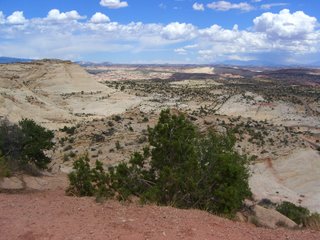 Our traverse of southern Utah brought us through our nation's largest national monument and one of its lesser known national parks. Grand Staircase-Escalante was declared a national monument by Bill Clinton in 1996, pursuant to the Antiquities Act, which enables the president to make unilateral designations in the case of features of significant cultural or scientific interest and may also protect surrounding parcels of land limited to the smallest area compatible with the underlying purpose. Well, in an election year stunt, Clinton declared 1.9 million acres in Utah as a national monument, withdrawing that land from extractive uses. However, Clinton kept the land under the oversight of the Bureau of Land Management, rather than transferring it to the National Park Service. The Bureau of Livestock and Mining, as it is derisively known by its critics, now had to manage the land for preservation purposes -- a mandate outside its general purview of resource extraction. Anyhow, Grand Staircase features some amazing panoramic views of the countryside with mountains and cliffs and canyons and rivers on a gigantic scale, along with some fascinating insight into the geologic history of the area.
Our traverse of southern Utah brought us through our nation's largest national monument and one of its lesser known national parks. Grand Staircase-Escalante was declared a national monument by Bill Clinton in 1996, pursuant to the Antiquities Act, which enables the president to make unilateral designations in the case of features of significant cultural or scientific interest and may also protect surrounding parcels of land limited to the smallest area compatible with the underlying purpose. Well, in an election year stunt, Clinton declared 1.9 million acres in Utah as a national monument, withdrawing that land from extractive uses. However, Clinton kept the land under the oversight of the Bureau of Land Management, rather than transferring it to the National Park Service. The Bureau of Livestock and Mining, as it is derisively known by its critics, now had to manage the land for preservation purposes -- a mandate outside its general purview of resource extraction. Anyhow, Grand Staircase features some amazing panoramic views of the countryside with mountains and cliffs and canyons and rivers on a gigantic scale, along with some fascinating insight into the geologic history of the area.Capitol Reef is an underappreciated national park largely because what it seeks to preserve, a feature known as the Waterpocket Fold, is located a two-hour off-road drive from the main park thoroughfare. The Waterpocket Fold is basically a wrinkle in the earth's crust that has eroded away. What remains is a sheer cliff wall, known by pioneers as a reef, met by a gently sloping collection of white bulbous features that resemble the United States Capitol. Hence the name. The park also features many red rock geologic formations.
For my Grand Staircase and Capitol Reef photo album, click here.
No comments:
Post a Comment